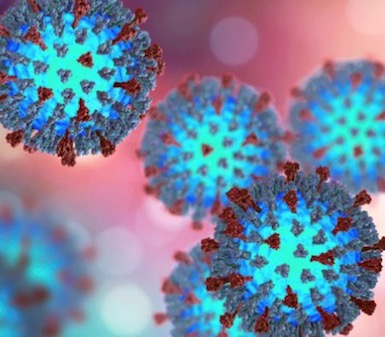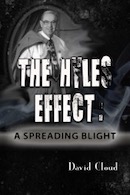866-295-4143, fbns@wayoflife.org

“Viruses were here long before us. They were here before intelligent life, before apes and chimpanzees, before reptiles, before anything crawled out of the slime of creation. Viruses are ubiquitous, but their mystery is inherent in their origin: we don’t know exactly how they developed, but we do know they have been around for millions of years. ... A virus is a box of chemicals, without the structures of a basic cell. It cannot metabolize or replicate on its own. In order to reproduce, it must invade living cells. Viruses infect bacteria and plants, reptiles, fish, birds, and mammals” (Influenza: The Hundred Year Hunt, p. 29).
Dr. Brown is a veteran Emergency Room doctor and director of the Office of Emergency Care Research at the National Institutes of Health. Yet he spirals into “Just so land” when he describes the origin of viruses.
He paints an impossible scenario. Not only is there zero evidence for it, it is impossible on its very face based on the information about viruses that Dr. Brown gives in his own book. A virus could not have evolved and lived without a host. And it had to have been programmed with information about the host and to have had the ability from the moment of its inception to find the host cell, to recognize it, to invade the cell, to take over the complex machinery of the cell, to make copies of itself with that machinery, to send those copies back out of the cell, to dis-attach them from the cell membrane, and to invade new cells. All of this is described in Dr. Brown’s book.
The virus itself, and every aspect of its life cycle, is so complex that modern science only understands a very tiny part of it. Dr. Jeff Taubenberger is Chief of the Viral Pathogenesis and Evolution Section, Laboratory of Infectious Diseases, National Institutes of Health. He was the first to sequence the genome of the 1918 Spanish flu virus. Dr. Jeremy Brown calls him “the man who knows more about influenza than anyone.” Yet Taubenberger says, “I’ve been thinking heavily about the flu for twenty years, AND I KNOW NOTHING” (Influenza: The Hundred Year Hunt, p. 97).
He says that because he understands and acknowledges that modern science knows almost nothing about genetics in light of what there is to know. That speaks volumes about the great complexity of even the simplest elements of life, such as viruses.
If a “simple” flu virus is this complicated, scientists of all people should open their eyes and see that nothing living evolved. Life simply could not have happened that way. It is not a process of auto-generation, genetic mutations, and natural selection. There has to be another explanation, because that one is a dead end street.
Charles Darwin didn’t know what modern scientists know. In Darwin’s day, the cell was thought to be a simple blob of protoplasm. Working within the realm of this ignorance, it was perhaps possible for evolutionists to believe that blind, unintelligent natural processes could have produced life. Darwin’s influential German disciple Ernst Haeckel (creator of the “embryo chart”) believed that life is constantly forming in the mud at the bottom of the sea. He called this mythical living substance “monera” and believed it provided the base of the “tree of life.” In The History of Creation (1868) he described the appearance, eating habits, and reproductive cycle of monera. He even drew pictures of them. “They consist entirely of shapeless, simple homogeneous matter ... a shapeless, mobile, little lump of mucus or slime ... organisms without organs.”
One hundred and fifty years later, we know that the simplest living cell is a complex body with organs. It is similar to a modern city in many ways, yet it is far more complicated than a modern city. It has a command center, blueprints, decoders, error checkers, quality control systems, power generators, power storage units, manufacturing plants, chemical plants, assembly lines, disposal units, trash compactors, a complex communication system, recycling centers, detoxification plants, transportation highways and tracks and tunnels, transportation vehicles, living walls with many types of one-way and two-way guarded, gated portals to the outside world, an external matrix to connect with other cells. It has police and soldiers and a host of other things.
Henry Zuill, Ph.D. in biology, says, “Complexity of the cell is now just too daunting to flippantly assert biochemical evolution to explain it ... And if cells could not originate naturally, then nothing else could” (In Six Days: Why Fifty Scientists Choose to Believe in Evolution, edited by John Ashton).
Stephen Grocott, Ph.D. in organometallic chemistry from the University of Western Australia, says, “I enjoy seeing the mental gymnastics of people trying to explain the origin of life. Most researchers in the area are honest enough to say they haven’t got the faintest idea how life began from non-life. The mind boggles at the complexity of the simplest single-celled organism--and the more we learn, the more complex it looks” (“The Creation Couple,” The Genesis Files, edited by Carl Wieland, p. 68).
Francis Crick, co-discoverer of DNA’s double helix structure, was at one time an evolutionist and an opponent of Christianity, but he realized that life could not have spontaneously arisen in “a warm pond.” Crick wrote, “An honest man, armed with all the knowledge available to us now, could only state that in some sense, the origin of life appears at the moment to be almost a miracle, so many are the conditions which would have had to have been satisfied to get it going” (Life Itself: Its Origin and Nature, 1981, p. 88).
Esteemed British scientist Sir Fred Hoyle reached the same conclusion. He called the idea of life evolving by chance in a primordial soup “nonsense of a high order.” He likened such an event to “a tornado sweeping through a junk-yard assembling a Boeing 747 from the materials therein” and “a solar system full of blind men solving Rubik's Cubes simultaneously.”
There are many hypotheses as to how life evolved from non-life, but they are more ridiculous than realistic. They amount to nothing more than a batch of Rudyard Kipling “just so” stories. Wild yarns. Not one of the hypotheses provides a realistic bridge of the gulf from non-life to life, from inert chemicals to living, self-replicating systems, from non-intelligence to great intelligence.
This is true for the prokaryote cell “theory,”, the RNA-first “theory,”, the deep sea vent “theory,”, the peptide “theory,”, the iron-sulfur “theory,”, the autocatalysis “theory,”, the clay “theory,”, the catalytic noise “theory,”, and all the others.
“Thou, even thou, art LORD alone; thou hast made heaven, the heaven of heavens, with all their host, the earth, and all things that are therein, the seas, and all that is therein, and thou preservest them all; and the host of heaven worshippeth thee” (Nehemiah 9:6).
“In the beginning was the Word, and the Word was with God, and the Word was God. The same was in the beginning with God. All things were made by him; and without him was not any thing made that was made. In him was life; and the life was the light of men” (John 1:1-4).
“Who is the image of the invisible God, the firstborn of every creature: For by him [Jesus Christ] were all things created, that are in heaven, and that are in earth, visible and invisible, whether they be thrones, or dominions, or principalities, or powers: all things were created by him, and for him: And he is before all things, and by him all things consist” (Colossians 1:15-17). The following paragraph is from Dr. Jeremy Brown’s fascinating and highly educational book Influenza: The Hundred Year Hunt to Cure the Deadliest Disease in History (New York: Touchstone, 2018) -
“Viruses were here long before us. They were here before intelligent life, before apes and chimpanzees, before reptiles, before anything crawled out of the slime of creation. Viruses are ubiquitous, but their mystery is inherent in their origin: we don’t know exactly how they developed, but we do know they have been around for millions of years. ... A virus is a box of chemicals, without the structures of a basic cell. It cannot metabolize or replicate on its own. In order to reproduce, it must invade living cells. Viruses infect bacteria and plants, reptiles, fish, birds, and mammals” (Influenza: The Hundred Year Hunt, p. 29).
Dr. Brown is a veteran Emergency Room doctor and director of the Office of Emergency Care Research at the National Institutes of Health. Yet he spirals into “Just so land” when he describes the origin of viruses.
He paints an impossible scenario. Not only is there zero evidence for it, it is impossible on its very face based on the information about viruses that Dr. Brown gives in his own book. A virus could not have evolved and lived without a host. And it had to have been programmed with information about the host and to have had the ability from the moment of its inception to find the host cell, to recognize it, to invade the cell, to take over the complex machinery of the cell, to make copies of itself with that machinery, to send those copies back out of the cell, to dis-attach them from the cell membrane, and to invade new cells. All of this is described in Dr. Brown’s book.
The virus itself, and every aspect of its life cycle, is so complex that modern science only understands a very tiny part of it. Dr. Jeff Taubenberger is Chief of the Viral Pathogenesis and Evolution Section, Laboratory of Infectious Diseases, National Institutes of Health. He was the first to sequence the genome of the 1918 Spanish flu virus. Dr. Jeremy Brown calls him “the man who knows more about influenza than anyone.” Yet Taubenberger says, “I’ve been thinking heavily about the flu for twenty years, AND I KNOW NOTHING” (Influenza: The Hundred Year Hunt, p. 97).
He says that because he understands and acknowledges that modern science knows almost nothing about genetics in light of what there is to know. That speaks volumes about the great complexity of even the simplest elements of life, such as viruses.
If a “simple” flu virus is this complicated, scientists of all people should open their eyes and see that nothing living evolved. Life simply could not have happened that way. It is not a process of auto-generation, genetic mutations, and natural selection. There has to be another explanation, because that one is a dead end street.
Charles Darwin didn’t know what modern scientists know. In Darwin’s day, the cell was thought to be a simple blob of protoplasm. Working within the realm of this ignorance, it was perhaps possible for evolutionists to believe that blind, unintelligent natural processes could have produced life. Darwin’s influential German disciple Ernst Haeckel (creator of the “embryo chart”) believed that life is constantly forming in the mud at the bottom of the sea. He called this mythical living substance “monera” and believed it provided the base of the “tree of life.” In The History of Creation (1868) he described the appearance, eating habits, and reproductive cycle of monera. He even drew pictures of them. “They consist entirely of shapeless, simple homogeneous matter ... a shapeless, mobile, little lump of mucus or slime ... organisms without organs.”
One hundred and fifty years later, we know that the simplest living cell is a complex body with organs. It is similar to a modern city in many ways, yet it is far more complicated than a modern city. It has a command center, blueprints, decoders, error checkers, quality control systems, power generators, power storage units, manufacturing plants, chemical plants, assembly lines, disposal units, trash compactors, a complex communication system, recycling centers, detoxification plants, transportation highways and tracks and tunnels, transportation vehicles, living walls with many types of one-way and two-way guarded, gated portals to the outside world, an external matrix to connect with other cells. It has police and soldiers and a host of other things.
Henry Zuill, Ph.D. in biology, says, “Complexity of the cell is now just too daunting to flippantly assert biochemical evolution to explain it ... And if cells could not originate naturally, then nothing else could” (In Six Days: Why Fifty Scientists Choose to Believe in Evolution, edited by John Ashton).
Stephen Grocott, Ph.D. in organometallic chemistry from the University of Western Australia, says, “I enjoy seeing the mental gymnastics of people trying to explain the origin of life. Most researchers in the area are honest enough to say they haven’t got the faintest idea how life began from non-life. The mind boggles at the complexity of the simplest single-celled organism--and the more we learn, the more complex it looks” (“The Creation Couple,” The Genesis Files, edited by Carl Wieland, p. 68).
Francis Crick, co-discoverer of DNA’s double helix structure, was at one time an evolutionist and an opponent of Christianity, but he realized that life could not have spontaneously arisen in “a warm pond.” Crick wrote, “An honest man, armed with all the knowledge available to us now, could only state that in some sense, the origin of life appears at the moment to be almost a miracle, so many are the conditions which would have had to have been satisfied to get it going” (Life Itself: Its Origin and Nature, 1981, p. 88).
Esteemed British scientist Sir Fred Hoyle reached the same conclusion. He called the idea of life evolving by chance in a primordial soup “nonsense of a high order.” He likened such an event to “a tornado sweeping through a junk-yard assembling a Boeing 747 from the materials therein” and “a solar system full of blind men solving Rubik's Cubes simultaneously.”
There are many hypotheses as to how life evolved from non-life, but they are more ridiculous than realistic. They amount to nothing more than a batch of Rudyard Kipling “just so” stories. Wild yarns. Not one of the hypotheses provides a realistic bridge of the gulf from non-life to life, from inert chemicals to living, self-replicating systems, from non-intelligence to great intelligence.
This is true for the prokaryote cell “theory,”, the RNA-first “theory,”, the deep sea vent “theory,”, the peptide “theory,”, the iron-sulfur “theory,”, the autocatalysis “theory,”, the clay “theory,”, the catalytic noise “theory,”, and all the others.
“Thou, even thou, art LORD alone; thou hast made heaven, the heaven of heavens, with all their host, the earth, and all things that are therein, the seas, and all that is therein, and thou preservest them all; and the host of heaven worshippeth thee” (Nehemiah 9:6).
“In the beginning was the Word, and the Word was with God, and the Word was God. The same was in the beginning with God. All things were made by him; and without him was not any thing made that was made. In him was life; and the life was the light of men” (John 1:1-4).
“Who is the image of the invisible God, the firstborn of every creature: For by him [Jesus Christ] were all things created, that are in heaven, and that are in earth, visible and invisible, whether they be thrones, or dominions, or principalities, or powers: all things were created by him, and for him: And he is before all things, and by him all things consist” (Colossians 1:15-17).
- Receive these reports by email
- www.wayoflife.org
______________________
Sharing Policy: Much of our material is available for free, such as the hundreds of articles at the Way of Life web site. Other items we sell to help fund our expensive literature and foreign church planting ministries. Way of Life's content falls into two categories: sharable and non-sharable. Things that we encourage you to share include the audio sermons, O Timothy magazine, FBIS articles, and the free eVideos and free eBooks. You are welcome to make copies of these at your own expense and share them with friends and family. You may also post parts of reports and/or entire reports to websites, blogs, etc as long as you give proper credit (citation). A link to the original report is very much appreciated as the reports are frequently updated and/or expanded. Things we do not want copied and distributed are "Store" items like the Fundamental Baptist Digital Library, print editions of our books, electronic editions of the books that we sell, the videos that we sell, etc. The items have taken years to produce at enormous expense in time and money, and we use the income from sales to help fund the ministry. We trust that your Christian honesty will preserve the integrity of this policy. "For the scripture saith, Thou shalt not muzzle the ox that treadeth out the corn. And, The labourer is worthy of his reward" (1 Timothy 5:18). Questions? support@wayoflife.org
Goal:Distributed by Way of Life Literature Inc., the Fundamental Baptist Information Service is an e-mail posting for Bible-believing Christians. Established in 1974, Way of Life Literature is a fundamental Baptist preaching and publishing ministry based in Bethel Baptist Church, London, Ontario, of which Wilbert Unger is the founding Pastor. Brother Cloud lives in South Asia where he has been a church planting missionary since 1979. Our primary goal with the FBIS is to provide material to assist preachers in the edification and protection of the churches.
Offering: Offerings are welcome if you care to make one. If you have been helped and/or blessed by our material offerings can be mailed or made online with with Visa, Mastercard, Discover, or Paypal. For information see: www.wayoflife.org/about/makeanoffering.html.





